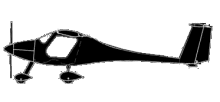
ASN Wikibase Occurrence # 200196
This information is added by users of ASN. Neither ASN nor the Flight Safety Foundation are responsible for the completeness or correctness of this information.
If you feel this information is incomplete or incorrect, you can submit corrected information.
| Date: | Saturday 11 March 2017 |
| Time: | 08:10 |
| Type: |  Pipistrel Virus |
| Owner/operator: | Private |
| Registration: | N345M |
| MSN: | 621 SW 100 |
| Year of manufacture: | 2014 |
| Total airframe hrs: | 103 hours |
| Engine model: | Rotax 912 ULS |
| Fatalities: | Fatalities: 0 / Occupants: 2 |
| Aircraft damage: | Substantial |
| Category: | Accident |
| Location: | Okmulgee, OK -
 United States of America United States of America
|
| Phase: | Standing |
| Nature: | Private |
| Departure airport: | Wellston, OK (43OK) |
| Okmulgee, OK (OKM) | |
| Investigating agency: | NTSB |
| Confidence Rating: |
The pilot reported that he entered the traffic pattern for runway 4 about 800 ft above the ground. He added that, after touchdown, he did not see the fence that ran across the runway until the airplane was about 300 ft from it. Subsequently, the airplane impacted the fence.
The airplane sustained substantial damage to the fuselage and right wing.
A review of the airport’s Federal Aviation Administration (FAA) chart supplement (02 MAR 2017 to 27 APR 2017) revealed that the runway the pilot landed on was depicted in the airport sketch with two “X” marks, which indicated that the runway was closed. A review of the visual flight rules sectional chart in publication at the time of the accident revealed that the surface the pilot landed was depicted along with the other runway surface at the airport.
The FAA Pilot’s Handbook of Aeronautical Knowledge stated, in part:
Marking and Lighting of Permanently Closed Runways and Taxiways
For runways and taxiways that are permanently closed, the lighting circuits are disconnected. The runway threshold, runway designation, and touchdown markings are obliterated and yellow “Xs” are placed at each end of the runway and at 1,000-foot intervals.
A review of photographs of the “X” markings on the surface the pilot landed on showed that only fragments of faded yellow paint were visible and that what was visible did not resemble an “X.”
Code of Federal Regulations Section 91.103, “Preflight Action,” stated, in part:
Each pilot in command shall, before beginning a flight, become familiar with all available information concerning that flight. This information must include— (a) For a flight under IFR [instrument flight rules] or a flight not in the vicinity of an airport, weather reports and forecasts, fuel requirements, alternatives available if the planned flight cannot be completed, and any known traffic delays of which the pilot in command has been advised by ATC [air traffic control]; (b) For any flight, runway lengths at airports of intended use, and the…takeoff and landing distance information.
The pilot did not report that he consulted the FAA chart supplement before landing, which depicted the runway closed.
Probable Cause: The pilot’s failure to review the Federal Aviation Administration chart supplement before landing, which resulted in his landing on a closed runway and collision with a fence. Contributing to the accident was the airport’s failure to adequately mark the physical surface of the runway to indicate that it was permanently closed.
Accident investigation:
 |
|
Sources:
NTSB
Location
Revision history:
| Date/time | Contributor | Updates |
|---|---|---|
| 04-Oct-2017 17:40 | ASN Update Bot | Added |
Corrections or additions? ... Edit this accident description
The Aviation Safety Network is an exclusive service provided by:


 ©2024 Flight Safety Foundation
©2024 Flight Safety Foundation